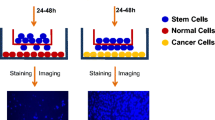Abstract
Cells expressing suicide genes can be used as therapeutic vehicles for difficult-to-treat tumors, for example, if stem cells are used that are able to track infiltrating tumor cells. An alternative application of suicide gene expression is their use as a safety switch in regenerative medicine where the presence of a few pluripotent stem cells could potentially cause unwanted side effects like the formation of teratoma. One potential bottleneck of these applications is that information on the initiation of cell suicide is needed early on, for example, when therapeutic cells have reached infiltrating tumor cells or when teratomas are formed. Therefore, in vivo imaging methods are needed that provide information on target location, (stem) cell location, (stem) cell viability, pathology, and suicide gene expression. This requires multimodal imaging approaches that can provide this information longitudinally and in a noninvasive way. Here, we describe examples of how therapeutic cells can be modified so that they express a suicide gene and genes that can be used for in vivo visualization.
Access this chapter
Tax calculation will be finalised at checkout
Purchases are for personal use only
Similar content being viewed by others
References
Leten C, Trekker J, Struys T, Dresselaers T, Gijsbers R, Vande Velde G, Lambrichts I, Van der Linden A, Verfaillie CM, Himmelreich U (2015) Assessment of bystander killing-mediated therapy of malignant brain tumors using a multimodal imaging approach. Stem Cell Res Ther 6:163
Burns TC, Steinberg GK (2011) Stem cells and stroke: opportunities, challenges and strategies. Expert Opin Biol Ther 11:447–461
Gürsel DB, Berry N, Boockvar JA (2012) Therapeutic stem cells encapsulated in a synthetic extracellular matrix selectively kill tumor cells, delay tumor growth, and increase survival in a mouse resection model of malignant glioma. Neurosurgery 70:N17–N19
Kucerova L, Altanerova V, Matuskova M et al (2007) Adipose tissue-derived human mesenchymal stem cells mediated prodrug cancer gene therapy. Cancer Res 67:6304–6313
Miletic H, Fischer Y, Litwak S et al (2007) Bystander killing of malignant glioma by bone marrow-derived tumor-infiltrating progenitor cells expressing a suicide gene. Mol Ther 15:1373–1381
Matuskova M, Hlubinova K, Pastorakova A et al (2010) HSV-tk expressing mesenchymal stem cells exert bystander effect on human glioblastoma cells. Cancer Lett 290:58–67
Leten C, Trekker J, Struys T, Roobrouck VD, Dresselaers T, Vande Velde G, Lambrichts I, Verfaillie CM, Himmelreich U (2016) Monitoring the bystander killing effect of human multipotent stem cells for treatment of malignant brain tumors. Stem Cells Int 2016:e4095072
Arnhold S, Klein H, Semkova I, Addicks K, Schraermeyer U (2004) Neurally selected embryonic stem cells induce tumor formation after long-term survival following engraftment into the subretinal space. Invest Ophthalmol Vis Sci 45:4251–4255
Blum B, Benvenisty N (2009) The tumorigenicity of diploid and aneuploid human pluripotent stem cells. Cell Cycle 8:3822–3830
Leten C, Roobrouck VD, Struys T et al (2014) Controlling and monitoring stem cell safety in vivo in an experimental rodent model. Stem Cells 32:2833–2844
Duarte S, Carle G, Faneca H, de Lima MC, Pierrefite-Carle V (2012) Suicide gene therapy in cancer: where do we stand now? Cancer Lett 324:160–170
Neyrinck K, Breuls N, Holvoet B et al (2018) The human somatostatin receptor type 2 as an imaging and suicide reporter gene for pluripotent stem cell-derived therapy of myocardial infarction. Theranostics 8: 2799–2813
Strosberg J, El-Haddad G, Wolin E, Hendifar A, Yao J, Chasen B et al (2017) Phase 3 trial of 177Lu-Dotatate for midgut neuroendocrine tumors. N Engl J Med 376:125–135
Mori K, Iwata J, Miyazaki M, Osada H, Tange Y, Yamamoto T et al (2010) Bystander killing effect of thymidine kinase gene-transduced adult bone marrow stromal cells with ganciclovir on malignant glioma cells. Neurol Med Chir (Tokyo) 50:545–553
Deroose CM, Reumers V, Gijsbers R, Bormans G, Debyser Z, Mortelmans L et al (2006) Noninvasive monitoring of long-term lentiviral vector-mediated gene expression in rodent brain with bioluminescence imaging. Mol Ther 14:423–431
Waerzeggers Y, Klein M, Miletic H, Himmelreich U, Li H, Monfared P et al (2008) Multimodal imaging of neural progenitor cell fate in rodents. Mol Imaging 7:77–91
Himmelreich U, Hoehn M (2008) Stem cell labeling for magnetic resonance imaging. Minim Invasive Ther Allied Technol 17:132–142
Wolfs E, Holvoet B, Gijsbers R, Casteels C, Roberts SJ, Struys T et al (2014) Optimization of multimodal imaging of mesenchymal stem cells using the human sodium iodide symporter for PET and Cerenkov luminescence imaging. PLoS One 9:e94833
Wolfs E, Holvoet B, Ordovas L, Breuls N, Helsen N, Schönberger M et al (2017) Molecular imaging of human embryonic stem cells stably expressing human PET reporter genes after zinc finger nuclease-mediated genome editing. J Nucl Med 58:1659–1665
Himmelreich U, Dresselaers T (2009) Cell labeling and tracking for experimental models using magnetic resonance imaging. Methods 48:112–124
Jacobs AH, Winkeler A, Hartung M, Slack M, Dittmar C, Kummer C (2003) Improved herpes simplex virus type 1 amplicon vectors for proportional coexpression of positron emission tomography marker and therapeutic genes. Hum Gene Ther 14:277–297
Miletic H, Fischer YH, Giroglou T, Rueger MA, Winkeler A, Li H, Himmelreich U et al (2007) Normal brain cells contribute to the bystander effect in suicide gene therapy of malignant glioma. Clin Cancer Res 13:6761–6768
Chiba K, Hockemeyer D (2015) Genome editing in human pluripotent stem cells using site-specific nucleases. Methods Mol Biol 1239:267–280
Author information
Authors and Affiliations
Corresponding author
Editor information
Editors and Affiliations
Rights and permissions
Copyright information
© 2019 Springer Science+Business Media, LLC, part of Springer Nature
About this protocol
Cite this protocol
Holvoet, B., Leten, C., Deroose, C.M., Himmelreich, U. (2019). Noninvasive Monitoring of Suicide Gene Therapy by Using Multimodal Molecular Imaging. In: Düzgüneş, N. (eds) Suicide Gene Therapy. Methods in Molecular Biology, vol 1895. Humana Press, New York, NY. https://doi.org/10.1007/978-1-4939-8922-5_10
Download citation
DOI: https://doi.org/10.1007/978-1-4939-8922-5_10
Published:
Publisher Name: Humana Press, New York, NY
Print ISBN: 978-1-4939-8921-8
Online ISBN: 978-1-4939-8922-5
eBook Packages: Springer Protocols




